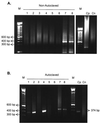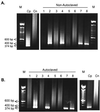Electropositive filter membrane as an alternative for the elimination of PCR inhibitors from sewage and water samples
- PMID: 11571164
- PMCID: PMC93211
- DOI: 10.1128/AEM.67.10.4614-4618.2001
Electropositive filter membrane as an alternative for the elimination of PCR inhibitors from sewage and water samples
Abstract
PCR is the best method for the detection of enteric viruses present at low concentrations in environmental samples. However, some organic and inorganic compounds present in these samples can interfere in the reaction. Many of these substances are cytotoxic, too. The ZP60S filter membranes used in addition to fluorpentane treatment are quite efficient for virus concentration and simultaneous elimination of cytotoxicity from environmental samples. In this study, both procedures were used to promote the elimination of reverse transcriptase PCR (RT-PCR) inhibitors from sewage and sewage-polluted creek water. Samples were subjected separately to each of the following procedures: filtration through electropositive filter membranes (ZP60S), organic extraction with Vertrel XF, and filtration through ZP60S followed by organic extraction. Afterwards, aliquots were experimentally inoculated with rotavirus SA-11 RNA and subjected to RT-seminested PCR for amplification of the VP7 gene. Results showed that the ZP60S membranes efficiently eliminated the RT-PCR inhibitors from water samples. The sample processing method was also applied to 31 in natural sewage and creek water samples for detection of naturally occurring rotavirus. A duplex seminested PCR was used for the quick detection of couples of the four rotavirus genotypes (G1 to G4). Eight samples (25.8%) were positive, and rotavirus sequences were not detected in 23 (74.2%). Results were confirmed by direct immunoperoxidase method. In summary, the use of electropositive filter membrane is appropriate for the elimination of substances that can interfere with RT-PCR, obviating additional sample purification methods.
Figures



References
-
- Agbalika F, Wullenweber M, Prevot J. Preliminary evaluation of the ELISA as a tool for the detection of rotavirus in activated sewage sludge. Zentbl Bakteriol Hyg I. 1985;180:534–539. - PubMed
-
- Clesceri L S, Greenberg A E, Eaton A D, editors. Standard methods for the examination of water and wastewater. 20th ed. Washington, D.C.: American Public Health Association; 1998.
-
- Dahling D R, Wright B A, Williams F P. Detection of viruses in environmental samples: suitability of commercial rotavirus and adenovirus test kits. J Virol Methods. 1993;45:137–147. - PubMed
Publication types
MeSH terms
Substances
LinkOut - more resources
Full Text Sources

